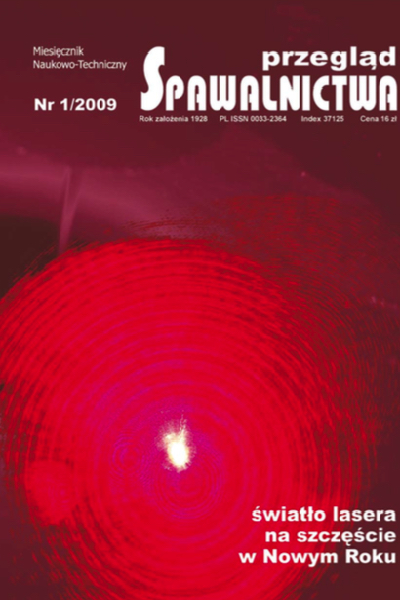Wizyjna kontrola rozmiaru jeziorka spawalniczego w czasie rzeczywistym
Main Article Content
Abstract
W artykule omówiono technikę komputerowego przetwarzania obrazów, opartą na pomiarze i kontroli w czasie rzeczywistym powierzchni lub rozmiaru jeziorka spawalniczego od strony źródła ciepła i od strony przetopu. Wykazano możliwości zastosowania komputerowego przetwarzania obrazu do utrzymania wymiarów przez wykonanie pomiarów oraz sterowanie procesem topienia i formowania spoiny. Opracowano algorytm analizy obrazu oparty na porównywaniu z wzorcem, który może być dobrany dla różnych metod spawania. Regulacja szerokości powierzchni jeziorka spawalniczego od strony źródła ciepła, za pomocą prostego klasycznego algorytmu sterowania ze sprzężeniem zwrotnym, umożliwia polepszenie jednorodności i powtarzalności spoiny przy zmieniających się warunkach odprowadzenia ciepła.
Real-time vision based control of weld pool size
A computer vision technique based on the real-time measurement and control of the upper surface or ‘topface weld pool size is discussed. The primary objective has been to demonstrate the feasibility of using vision based image processing to provide measurements and the subsequent control of weld geometrical properties during the weld formation or molten phase. A novel reference feature correlation based image analysis algorithm has been developed that may be configured to operate with a number of different welding processes. Upper surface weld pool with regulation via a simple classical feedback control algorithm has then been demonstrated to show how this approach may be used to improve weld uniformity and repeatability.
Downloads
Article Details
Creative Commons CC BY 4.0 https://creativecommons.org/licenses/by/4.0/
Welding Technology Review (WTR) articles are published open access under a CC BY licence (Creative Commons Attribution 4.0 International licence). The CC BY licence is the most open licence available and considered the industry 'gold standard' for open access; it is also preferred by many funders. This licence allows readers to copy and redistribute the material in any medium or format, and to alter, transform, or build upon the material, including for commercial use, providing the original author is credited.
References
I.S. Kim, Y.J. Jeong, P.K.D.V. Yarlagadda: Prediction of welding parameters for pipeline welding using an intelligent system, Int. Jnl. of Adv. Man. Tech. 22 (9-10) 2003.
C. Balfour, J. Lucas, S. Maqbool, J.S. Smith, S. Maqbool, L. Meilroy: Aneural Network Model for MIG Welding Parameter Prediction, Proc. 10th Int. Conf. On Computer Technology in Welding, June 2000.
J. Gaqo, C. Wu: Extracting weld penetration information in tungsten-inert gas welding, Proc. of Inst. of Mech. Engn. Part B Jnl. of Eng. Man. 216 (2) 2002.
J. Zhao, M.A. Houghton, C. Balfour, J.S. Smith and J. Lucas: Real Time Image Processing for Penetration Control In Automated Welding, Proc. 8th Int. Conf. on Computer Technology in Welding, June 1998.
H. Luo, R. Devanathan, J. Wang, X. Cheng, Z.Sun: Vision based neurofuzzy logic control of weld pool geometry, Sci. and Techn. of Welding and Joi. 7, (5) 2002.
Y. M. Zhang, R. Kovacevic: Neurofuzzy model-based predictive control of weld fusion zone geometry, IEEE Trans. on Fuzzy Sys. 6 (3) 1998.
D.B. Zhao, S.B. Chen, L. Wu, M. Dai, Q. Chen: Inteligent control for shape of the weld pool in pulsed GTAW with filler metal, 80 (11) (2001).
B. Zaration: Microsoft Visual C++6.0 programmer,s guide, Microsoft Press (1998).
J. Weiskamp, N.Johnson, F. Gauldt and M. Florence: How to Digitize Video, Wiley (1994).
M. Sonka, V. Hlavac, R. Boyle: Image Prosessing, Analysis and Machine Vision, 2nd. end. PWS Publishing (1999).
C.L. Phillips, H.T. Nagle: Digital Control System Analysis and Design, 3rd cdn. Prentice-hall (1995).
CAN Specification Version 2.0, Robert Bosh GmbH. (1991) [13] C. Balfonr, J.S. Smith: Controller Area Network (CAN) Applied to Welding Systems, Proc. 12th Int. Conf. on Computer Technology in Welding, sierpień 2002.
VEE Proc Users Guide, Agilent Technologies Inc. (2000).
K. Gregory, Using Visual C++.Net, Que/Sams publishing
(2002).
